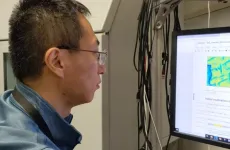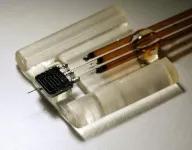(Press-News.org) University of Alaska Fairbanks researchers have devised a way to remotely detect large landslides within minutes of occurrence and to quickly determine whether they are close to open water and present a tsunami hazard.
They write in a new paper that their method of determining a landslide’s location, volume and potential impact is rapid enough to support the National Oceanic and Atmospheric Administration’s goal of issuing a tsunami warning within 5 minutes of a landslide.
“The warming climate is causing glaciers to retreat, leaving behind valleys whose mountainsides and hillsides have lost their support,” said research seismologist Ezgi Karasözen of the UAF Geophysical Institute. “This is important, especially in regions like southern coastal Alaska, because huge masses of land can and do spill into water and cause tsunamis.”
Karasözen and Michael West, director of the Alaska Earthquake Center at the Geophysical Institute, detailed their method in a paper published Feb. 9 in the journal The Seismic Record. West also serves as Alaska state seismologist.
Their paper calls attention to the danger by pointing to a 2015 landslide that sent 100 million cubic yards of rock into Alaska’s Taan Fjord, located off Icy Bay, 65 miles northwest of Yakutat. The slide created a tsunami that stripped vegetation as high as 620 feet above waterline.
A prototype system by Karasözen and West capable of real-time detection has been in place since August in the area of the Barry Arm of Prince William Sound. It uses data from seismic stations already in the Alaska network.
State and federal agencies fear a landslide and tsunami could occur at Barry Arm, where Barry Glacier has retreated and left behind an unsupported fjord wall that has slumped about 650 feet in recent decades. Retrospective analysis of seismic station data at Barry Arm revealed three landslides that occurred in 2020 and 2021.
Karasözen and West write that the instability “has prompted concerns that a catastrophic failure could generate a tsunami with several meters of peak wave height reaching nearby communities in just 20 minutes.”
The U.S. Geological Survey is leading the multifaceted interagency monitoring of the area.
“With an earthquake, there are instruments that measure ocean wave heights, and tsunami warning centers are on alert after an earthquake,” Karasözen said. “But landslides aren’t systematically monitored in Alaska or elsewhere in the world. If a landslide-triggered tsunami were to happen, we wouldn't know. That’s a major concern.”
The method by Karasözen and West involves quickly identifying a landslide’s long-period waves amid a seismic record busy with short-period waves created not only by a landslide but also by nearby earthquakes and glaciers and by human-caused activity.
A landslide’s initial onset generally registers as short-period waves; it isn’t until the slide accelerates that the identifiable long-period waves materialize. Landslides produce disproportionately more long-period energy compared with other sources. Most earthquake ruptures last only seconds, while landslides routinely last a minute or more.
Coastal fjords present a significant challenge for landslide detection because glaciers can create hundreds of prominent seismic events daily, the researchers write.
Karasözen and West created an algorithm to continually scan seismic data from multiple seismic stations to look for a landslide wave signature. Finding a match, their system will estimate the slide’s location and volume. In areas with good seismic station coverage, location can be estimated to within a few miles.
The goal is to have the system alert tsunami and seismology agency personnel, but more work remains before that can occur.
To create the algorithm, the two researchers analyzed data of the three recent Barry Glacier landslides and six additional landslides — five of them in Southeast Alaska and one on the west side of lower Cook Inlet, across from the Kenai Peninsula.
Other efforts have been tried over recent decades. Several researchers have shown that landslide seismograms can be used to estimate location and volume, but those efforts usually were unique to a region, required considerable fine-tuning and were not designed for real-time purposes.
Determining landslide location from distant seismic stations doesn’t allow for real-time assessment, due to the time it would take for the seismic waves to reach those stations.
West said the research augments ongoing monitoring and alert efforts.
“The potential for real-time monitoring of large landslides is one important component of the interagency effort underway to address Alaska’s landslide challenge,” he said.
CONTACTS:
• Ezgi Karasozen, University of Alaska Fairbanks Geophysical Institute, ekarasozen@alaska.edu
• Michael E. West, University of Alaska Fairbanks Geophysical Institute, mewest@alaska.edu
• Rod Boyce, University of Alaska Fairbanks Geophysical Institute, 907-474-7185, rcboyce@alaska.edu
END
New detection method aims to warn of landslide tsunamis
2024-02-22
ELSE PRESS RELEASES FROM THIS DATE:
Little groundwater recharge in ancient Mars aquifer, according to new models
2024-02-22
Mars was once a wet world. The geological record of the Red Planet shows evidence for water flowing on the surface – from river deltas to valleys carved by massive flash floods.
But a new study shows that no matter how much rainfall fell on the surface of ancient Mars, very little of it seeped into an aquifer in the planet’s southern highlands.
A graduate student at The University of Texas at Austin made the discovery by modeling groundwater recharge dynamics for the aquifer using a range of methods ...
Human-AI coworking
2024-02-21
Though artificial intelligence decreases human error in experimentation, human experts outperform AI when identifying causation or working with small data sets.
To capitalize on AI and researcher strengths, ORNL scientists, in collaboration with colleagues at National Cheng Kung University, Taiwan, and the University of Tennessee, Knoxville, developed a human-AI collaboration recommender system for improved experimentation performance.
During experiments, the system’s machine learning algorithms, described in npj Computational Materials, display preliminary ...
Vlasov and Bashir groups develop nanoscale device for brain chemistry analysis
2024-02-21
Longstanding challenges in biomedical research such as monitoring brain chemistry and tracking the spread of drugs through the body require much smaller and more precise sensors. A new nanoscale sensor that can monitor areas 1,000 times smaller than current technology and can track subtle changes in the chemical content of biological tissue with sub-second resolution, greatly outperforming standard technologies.
The device, developed by researchers at the University of Illinois Urbana-Champaign, is silicon-based and takes advantage of techniques developed for microelectronics manufacturing. ...
MD Anderson researchers receive over $25.5 million in CPRIT funding
2024-02-21
HOUSTON ― The University of Texas MD Anderson Cancer Center today was awarded 16 grants totaling over $25.5 million from the Cancer Prevention and Research Institute of Texas (CPRIT) in support of cancer screening, early detection and prevention programs, faculty recruitment, and groundbreaking cancer research across all areas of the institution.
“We are grateful for CPRIT’s continued funding of impactful cancer research and prevention programs at MD Anderson, which propels our efforts to deliver new breakthroughs and to advance our mission to end cancer,” said Peter WT Pisters, M.D., president of MD Anderson. “These efforts are pivotal to our institutional strategy ...
Hippo signaling pathway gives new insight into systemic sclerosis
2024-02-21
Systemic sclerosis causes the skin to tighten and harden resulting in a potentially fatal autoimmune condition that is associated with lung fibrosis and kidney disease.
University of Michigan Health researchers have studied the pathology of systemic sclerosis to understand better the disease and identify key pathways in the disease process that can be targeted therapeutically.
A research team led by University of Michigan Health’s Dinesh Khanna, M.B.B.S., M.Sc., professor of rheumatology and Johann Gudjonsson, M.D., Ph.D., professor of dermatology, ...
Utah’s Bonneville Salt Flats has long been in flux
2024-02-21
It has been long assumed that Utah’s Bonneville Salt Flats was formed as its ancient namesake lake dried up 13,000 years ago. But new research from the University of Utah has gutted that narrative, determining these crusts did not form until several thousand years after Lake Bonneville disappeared, which could have important implications for managing this feature that has been shrinking for decades to the dismay of the racing community and others who revere the saline pan 100 miles west of Salt ...
UM School of Medicine receives $10.6 million in state funding for Abortion Clinical Care Training Program
2024-02-21
A $10.6 million training grant has been awarded to the University of Maryland School of Medicine (UMSOM) and University of Maryland, Baltimore (UMB) to administer Maryland’s Abortion Clinical Care Training Program. The grant will be used to expand the number of healthcare professionals with abortion care training, increase the racial and ethnic diversity among health care professionals with abortion care education, and support the identification of clinical sites needing training.
“Our training will target a major ...
Outsmarting chemo-resistant ovarian cancer
2024-02-21
· Most women with ovarian cancer develop resistance to chemotherapy
· Nanoparticle fools cancer cells and prevents cholesterol from entering
· More than 18,000 women a year die from ovarian cancer
CHICAGO --- Women diagnosed with ovarian cancer may initially respond well to chemotherapy, but the majority of them will develop resistance to treatment and die from the disease.
Now Northwestern Medicine scientists have discovered the Achilles heel of chemotherapy-resistant ovarian cancer — its hunger for cholesterol — and how to sneakily use that to destroy it.
In a new study, scientists first showed that chemotherapy-resistant ...
Does Russia stand to benefit from climate change?
2024-02-21
“There’s a narrative out there about climate change that says there are winners and losers. Even if most of the planet might lose from the changing climate, certain industries and countries stand to benefit. And Russia is usually at the tip of people’s tongues, with Russian officials even making the claim that Russia is a potential winner.”
This portrayal, described by Debra Javeline, associate professor of political science at the University of Notre Dame and lead author on the recently published study “Russia in a changing climate,” was debated ...
Researchers find possible solutions to reverse Alzheimer’s Disease impact
2024-02-21
University of North Carolina at Chapel Hill researchers have developed a new drug delivery platform that harnesses helical amyloid fibers designed to untwist and release drugs in response to body temperatures.
A new research paper published on Jan. 26 in Nature Communications reveals groundbreaking structural details into how diseases form much like Alzheimer’s disease. With this knowledge, the group may have uncovered a unique mechanism to reverse both the deposits and their impact on those suffering from these conditions.
UNC-Chapel Hill researcher Ronit Freeman ...




